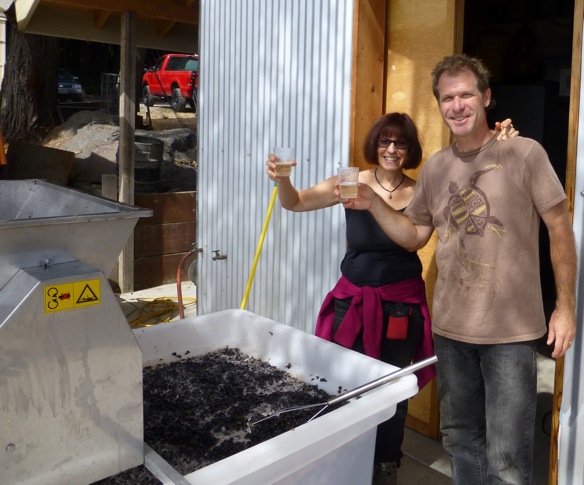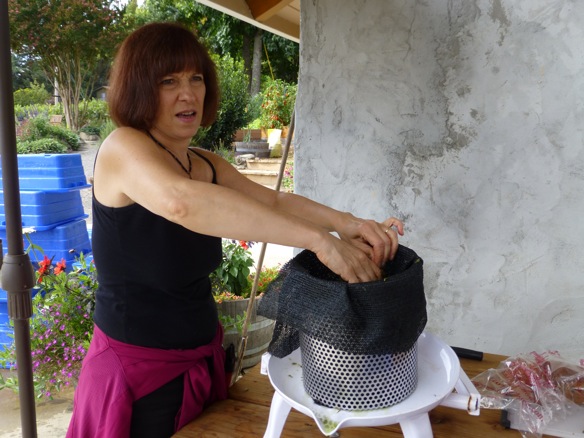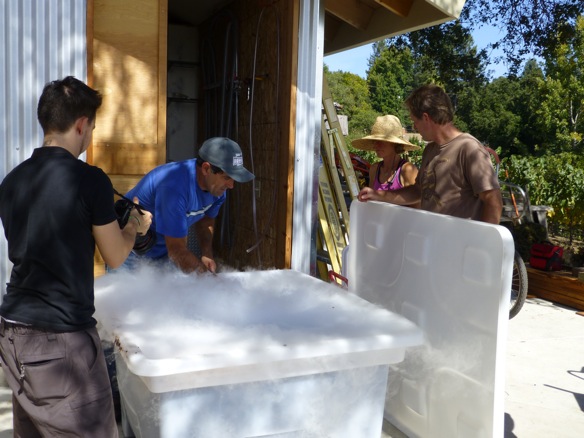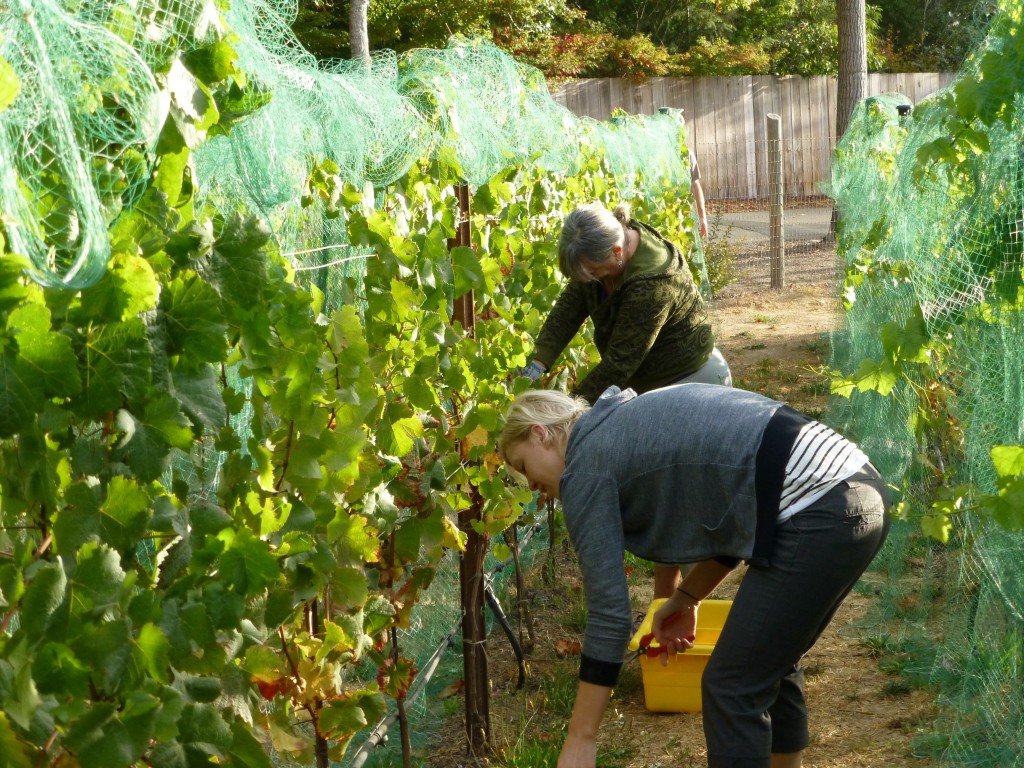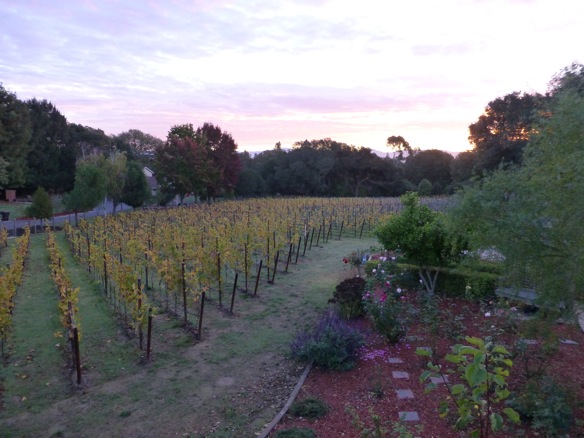 What can I say…I woke up this morning to a beautiful sunrise over the vineyard as the vines are showing fall colors!
What can I say…I woke up this morning to a beautiful sunrise over the vineyard as the vines are showing fall colors!
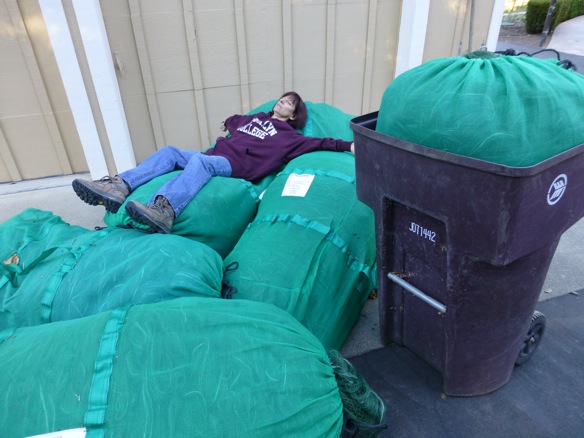 OK….so we finished the harvest and made wine….done yet. Nope, we had 3 miles of bird net that is 17 feet across to take in from the vineyard. Don’t know the official procedure, but we put the bags in a recycle bin, took off the nets from the vines, pulled them tight on the ground and then rolled the bin around and stuffed them in the bag. Each bag is about 100 pounds. Took us 24 hours! We had to finish by Sunday as it was supposed to rain Monday-Wednesday and they were on the ground and would have been full of mud. We finished, but you can see Joey was dead tired when it was over. Next year, I’m hoping to take them up the day before harvest so we can enjoy the fall colors on the leaves.
OK….so we finished the harvest and made wine….done yet. Nope, we had 3 miles of bird net that is 17 feet across to take in from the vineyard. Don’t know the official procedure, but we put the bags in a recycle bin, took off the nets from the vines, pulled them tight on the ground and then rolled the bin around and stuffed them in the bag. Each bag is about 100 pounds. Took us 24 hours! We had to finish by Sunday as it was supposed to rain Monday-Wednesday and they were on the ground and would have been full of mud. We finished, but you can see Joey was dead tired when it was over. Next year, I’m hoping to take them up the day before harvest so we can enjoy the fall colors on the leaves.
PS This next week I’m going to start pruning for next year.
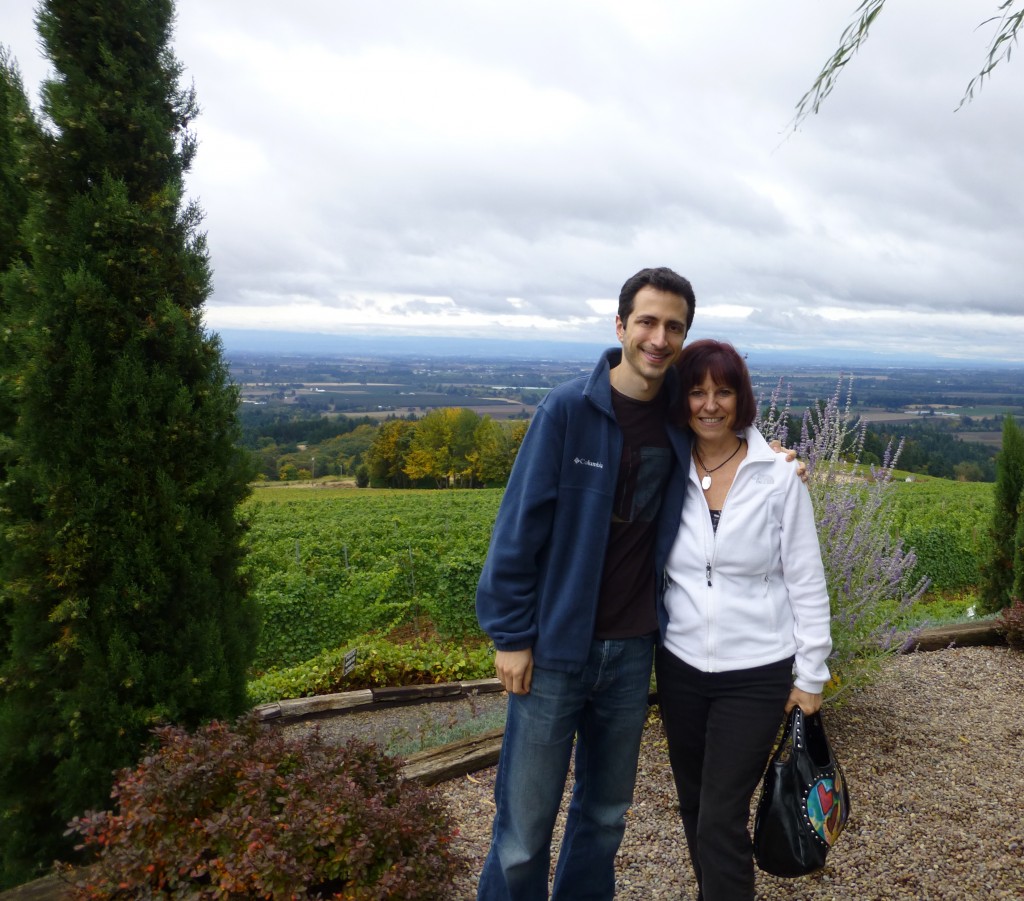 So….many of you are saying to yourselves, what is Doug going to do with himself all winter. Well, we decided to have a little fun and went to Portland for the weekend. Of course, we had to visit wineries and sample Pinot noir. Two big differences that we noticed and liked….they use less oak and have less alcohol.
So….many of you are saying to yourselves, what is Doug going to do with himself all winter. Well, we decided to have a little fun and went to Portland for the weekend. Of course, we had to visit wineries and sample Pinot noir. Two big differences that we noticed and liked….they use less oak and have less alcohol.
Seriously, in the vineyard I have to take all the nets off, start pruning, figure out where to fertilize for next year and control the gophers. In the winery I have to check on malolactic fermentation and rack the wines every 2-3 months and perform sulfur additions. And lastly, I have to get myself in shape for next years growing season as I will have (hopefully) four times the number of grapes as this year, or 5600 pounds!
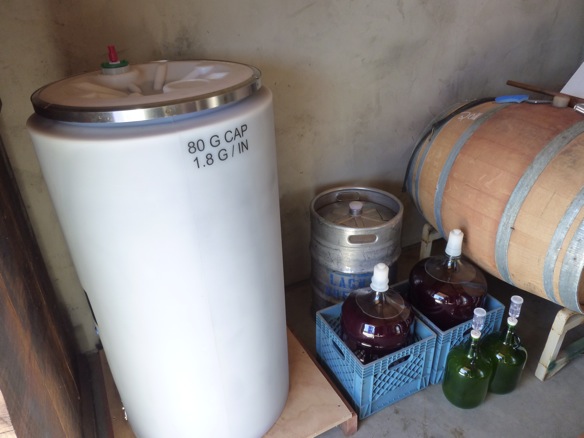 What is malolactic fermentation? Simply put, when the wine is pressed it contains a mix of tartaric acid, malic acid but no acetic acid. The wine at this stage is tart. This is good for Sauvignon blanc but not so good for red wine. Red wine in the presence of bacteria will convert the malic acit to acetic acid. This will raise the pH but more importantly will give the wine a much softer feel in your mouth. All red wines undergo MLF, but only a few white do this….mainly Chardonnay and some Sauvignon blanc’s.
What is malolactic fermentation? Simply put, when the wine is pressed it contains a mix of tartaric acid, malic acid but no acetic acid. The wine at this stage is tart. This is good for Sauvignon blanc but not so good for red wine. Red wine in the presence of bacteria will convert the malic acit to acetic acid. This will raise the pH but more importantly will give the wine a much softer feel in your mouth. All red wines undergo MLF, but only a few white do this….mainly Chardonnay and some Sauvignon blanc’s.
In our case, we are doing MLF on half of Nona’s Sauvignon blanc and all of the Pinot noir.
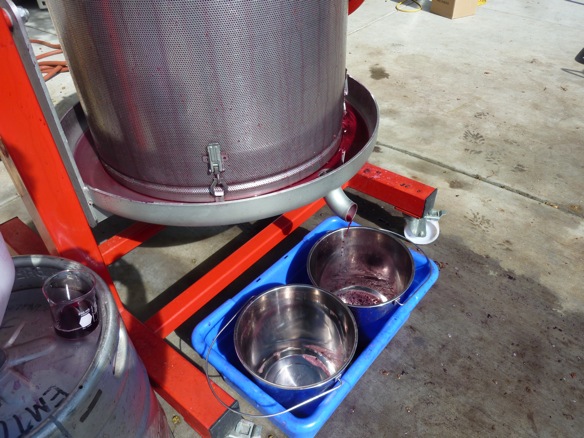 Pressing grapes on a small scale is so much fun! If you have been following along, we harvested grapes, cold soaked them for 6 days, then fermented them for 9 days and now after all the sugar has been converted to alcohol, and the must (grapes) have gone silent we press off the skins and seeds and only get juice. In the picture below you will see that we first siphon off the liquid on the bottom into your container. Then you take a bucket and get the wet grapes into the bladder press. All of the wine that is now in your container is called the “free run”. It is the most tart, lightest color and has the lowest pH. Many winemakers keep this separate when they perform malolactic fermentation, racking and aging of the wine. It is then blended into the other wine for balance or in many cases kept apart. All part of the winemaking art! Now you turn on the press and start to get juice from the grapes. This will take about 1-2 hours, depending on the strength of your press. In our case we had 80 gallons of free run and 27 gallons of pressed wine. Lastly, if you are there when the press is nearing the end, the wine is very dark and rich.
Pressing grapes on a small scale is so much fun! If you have been following along, we harvested grapes, cold soaked them for 6 days, then fermented them for 9 days and now after all the sugar has been converted to alcohol, and the must (grapes) have gone silent we press off the skins and seeds and only get juice. In the picture below you will see that we first siphon off the liquid on the bottom into your container. Then you take a bucket and get the wet grapes into the bladder press. All of the wine that is now in your container is called the “free run”. It is the most tart, lightest color and has the lowest pH. Many winemakers keep this separate when they perform malolactic fermentation, racking and aging of the wine. It is then blended into the other wine for balance or in many cases kept apart. All part of the winemaking art! Now you turn on the press and start to get juice from the grapes. This will take about 1-2 hours, depending on the strength of your press. In our case we had 80 gallons of free run and 27 gallons of pressed wine. Lastly, if you are there when the press is nearing the end, the wine is very dark and rich.
It was a great growing year for grapes, and the economy is coming back….so I should have known that everyone would have bumper crops and a barrel would be very difficult to come by.
First…why a barrel? It has to hold wine, breath and impart slight oak flavors. Most winemakers use about 30% new oak and then the rest 1 and 2 year old oak barrels. The older the barrel the more “neutral” it will be and won’t impart a lot of taste. So, with only a little over a barrel, I was looking for a 1 or 2 year old barrel. I called and visited about 30 wineries and custom crush facilities in the area, called Washington, Oregon, Colorado and even Canada. No used barrels. In the picture below my friend and winemaker John Mason tried to get some 2002 barrels to hold water but to no avail.
So, the same company that made my fermentation tank makes a plastic breathable barrel replacement. All you have to do is add oak staves (pieces) and they claim it is almost the same as a barrel with the added benefit of being able to clean it much easier, it can be sealed an pressurized with nitrogen and it has a sample port. So…necessity is the mother of invention.
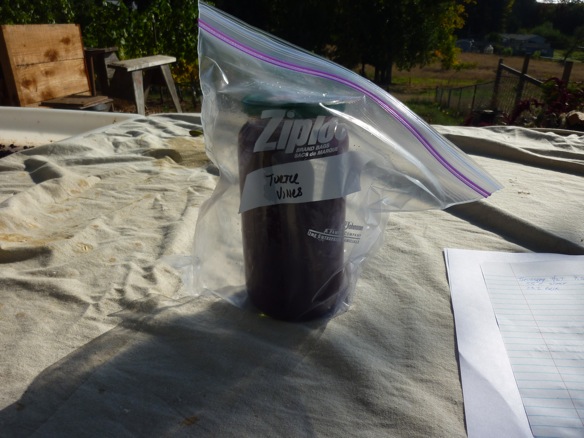 Why is this important? Most vineyards show potassium deficiency, however young vines in many cases produce berries high in potassium like our did, >2,000 ppm. An easy explanation….watering techniques. Early in the season, wen the growth rate is high, much of the potassium accumulates in the leaves. Then the potassium ions are moved from the leaves into the berries later in the season when the fruit starts to ripen. How is this controlled? Try not to water from the time the berries “set” on the vines to verasion (when they turn purple). This will limit the amount of potassium into the leaves that will be transferred to the berries. Due to the smallness of our vines and the shallow roots, I had to water them so they would be healthy. This, I think, shot up the potassium which in turn increased our pH of the berries later in the season. So, next year I will try and not water until verasion.
Why is this important? Most vineyards show potassium deficiency, however young vines in many cases produce berries high in potassium like our did, >2,000 ppm. An easy explanation….watering techniques. Early in the season, wen the growth rate is high, much of the potassium accumulates in the leaves. Then the potassium ions are moved from the leaves into the berries later in the season when the fruit starts to ripen. How is this controlled? Try not to water from the time the berries “set” on the vines to verasion (when they turn purple). This will limit the amount of potassium into the leaves that will be transferred to the berries. Due to the smallness of our vines and the shallow roots, I had to water them so they would be healthy. This, I think, shot up the potassium which in turn increased our pH of the berries later in the season. So, next year I will try and not water until verasion.
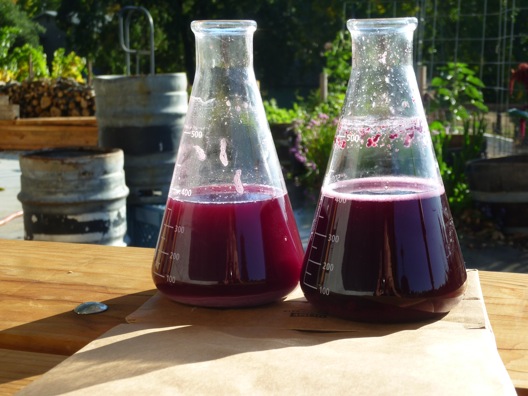 I learned so much this year in farming…but not as much in all the items I had to monitor prior to harvesting and in making good wine. I was looking at sugar content (around 23.5 to make 13.5% alcohol wine), seed color as the browner will tell me that the phenolics (ripeness) are ready but I didn’t monitor the pH. Why is that important? In a finished wine you want around 3.6 pH so that it will taste smooth but also age. The higher the pH the harder it is to age and the more sulfur you have to add when the wine is aging and in the bottle so it does not spoil. Therefore, you want your grapes at harvest to be around 3.4 because during fermentation, pressing and malolactic fermentation it will rise 0.2-0.3 units. When we picked the pH was 3.9 so I added tartaric acid to bring the pH closer to 3.7 before fermentation. Hopefully that is low enough.
I learned so much this year in farming…but not as much in all the items I had to monitor prior to harvesting and in making good wine. I was looking at sugar content (around 23.5 to make 13.5% alcohol wine), seed color as the browner will tell me that the phenolics (ripeness) are ready but I didn’t monitor the pH. Why is that important? In a finished wine you want around 3.6 pH so that it will taste smooth but also age. The higher the pH the harder it is to age and the more sulfur you have to add when the wine is aging and in the bottle so it does not spoil. Therefore, you want your grapes at harvest to be around 3.4 because during fermentation, pressing and malolactic fermentation it will rise 0.2-0.3 units. When we picked the pH was 3.9 so I added tartaric acid to bring the pH closer to 3.7 before fermentation. Hopefully that is low enough.
Oh, almost forgot…the higher the pH the lighter the color. So, I added pectic enzymes to the must during cold soak to enhance the color. The top picture is with and without enzymes. Pretty impressive so far, will have to see how it turns out in the finished product.
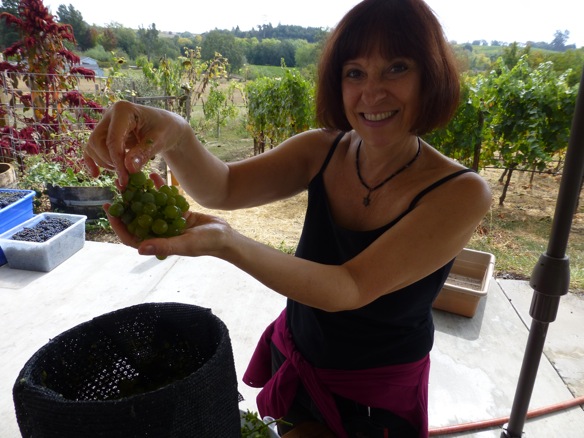 This will detail the fermentation of our first harvest of Pinot noir and Sauvignon blanc
This will detail the fermentation of our first harvest of Pinot noir and Sauvignon blanc
SAUVIGNON BLANC
Harvest – 9/23/12
Amount – ~20 lbs
Brix – 22.6
Yeast – VL1 (a Viogner type)
Manually crushed and de-stemmed into a small press. Press resulted in about 2 gallons of liquid. 10g of VL1 yeast was added to a 5 gallon carboy with a plastic cup on top at 1pm. 5ml of a 10% potassium meta-bisulfite solution was added as a preservative, approximately 35ppm.
9/24 – Lovely smell
10/4 – added mlf
 PINOT NOIR
PINOT NOIR
Harvest – 9/23/12
Amount – 34 picking tubs with ~35 lbs in each, or 1190 lbs, Brix – ~23.2 Crushed and de-stemmed at EMTU vineyards into a 1/2 ton bin. 32g of meta-bi-sulfite added as a preservative. Also added 40 lbs of dry ice. Temperature of must solution reduced from 62 F to 40 F.
9/24 – 48 F at noon
9/25 62 F at 9:30am Brix = 22.8 or 23.0 , Added 10 g Lallzyme Enzyme, 30# dry ice
9/27 55 F, added 40# dry ice, liquid very viscous due to enzymes
9/29 58 F, Added 1.5 g/l of tartaric acid and 0g assmanshausen yeast
9/30 62 F, brix 22, punch down
10/1 82 F, brix 19.8, punch down
10/2 88 F, brix 12.7 and 9.8, pH 3.84, punch down and added 0.5 g/l tartaric acid
10/3 90 F, brix 4.5, pH 3.82, great color much less viscous
10/4 81 F, brix -1.4
10/8 pH 3.76, very dark purple and cap has fallen….ready for pressing this morning.
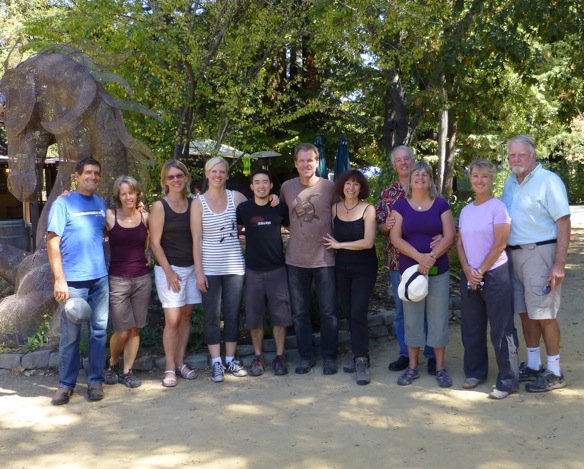 Harvest Happens at Turtle Vines….after only 4 short years of planning! We started on 9/23 at 8 am with nine friends and ended up picking 20 lbs of Sauvignon blanc (Brix 22.4) and around 1190 lbs of Pinot noir (Brix ~23). We finished picking at 11:00 and then went to EMTU Vineyards for crushing/destemming (another 1.5 hours) and adding sulfur/dry ice for a cold soak on the Pinot noir and sulfur/yeast for the Sauvignon blanc. I’ve added lots of pictures below….
Harvest Happens at Turtle Vines….after only 4 short years of planning! We started on 9/23 at 8 am with nine friends and ended up picking 20 lbs of Sauvignon blanc (Brix 22.4) and around 1190 lbs of Pinot noir (Brix ~23). We finished picking at 11:00 and then went to EMTU Vineyards for crushing/destemming (another 1.5 hours) and adding sulfur/dry ice for a cold soak on the Pinot noir and sulfur/yeast for the Sauvignon blanc. I’ve added lots of pictures below….
